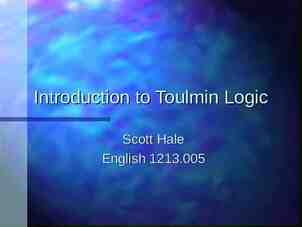Introduction to Python and programming Michael Ernst UW CSE 190p
22 Slides346.41 KB
Introduction to Python and programming Michael Ernst UW CSE 190p Summer 2012
1. Python is a calculator 2. A variable is a container 3. Different types cannot be compared 4. A program is a recipe
0. Don’t panic! CSE 190p is for people who have never programmed – (If you have programmed, you don’t belong here.) You can learn to program in 9 weeks – You will work hard – We will work hard to help you Ask questions! – This is the best way to learn
1. Python is a calculator
You type expressions. Python computes their values. 5 3 4 44/2 2**3 3*4 5*6 – If precedence is unclear, use parentheses (72 – 32) / 9 * 5
An expression is evaluated from the inside out How many expressions are in this Python code? an expression (72 – 32) / 9.0 * 5 values (72 – 32) / 9.0 * 5 (40) / 9.0 * 5 40 / 9.0 * 5 4.44 * 5 22.2
Another evaluation example (72 – 32) / (9.0 * 5) (40) / (9.0 * 5) 40 / (9.0 * 5) 40 / (1.8) 40 / 1.8 22.2
2. A variable is a container
Variables hold values Recall variables from algebra: – Let x 2 – Let y x To assign a variable, use “varname expression” pi 3.14 pi avogadro 6*10**23 avogadro 22 x # Error! No output from an assignment statement Not all variable names are permitted
Changing existing variables (“re-binding” or “re-assigning”) x 2 x y 2 y x 5 x y
Changing existing variables (“re-binding” or “re-assigning”) x 2 x y x y x 5 x y “ ” in an assignment is not a statement or promise of eternal equality Evaluating an expression gives a new (copy of a) number, rather than changing an existing one
How an assignment is executed 1. Evaluate the right-hand side to a value 2. Store that value in the variable x 2 print y x print z x print x 5 print print print State of the computer: x x: 5 2 y 1 z y: 2 z: 3 x y z Printed output: 2 2 3 5 2 3 To visualize a program’s execution:http:// people.csail.mit.edu/pgbovine/python/tutor.html
More expressions: Conditionals 22 4 22 4 22 4 x 100 # Assignment, not conditional! 22 4 # Error! x 5 x 100 x 200 not True Numeric operators: , *, ** not (x 200) Boolean operators: not, and, or 3 4 and 5 6 Mixed operators: , , 4 3 or 5 6 temp 72 water is liquid temp 32 and temp 212
More expressions: strings A string represents text 'Python' myclass "CSE 190p" "" Empty string is not the same as an unbound variable Operations: Length: len(myclass) Concatenation: "Michael" 'Ernst' Containment/searching: '0' in myclass "O" in myclass
3. Different types cannot be compared
Types of values Integers (int): -22, 0, 44 – Arithmetic is exact – Some funny representations: 12345678901L Real numbers (float, for “floating point”): 2.718, 3.1415 – Arithmetic is approximate, e.g., 6.022*10**23 – Some funny representations: 6.022e 23 Strings (str): "I love Python", "" Truth values (bool, for “Boolean”): True, False George Boole
Operations behave differently on different types 3.0 3 3 "3" 3 3 4.0 4 4.0 "4" "4" # Error True # Insanity! Moral: Python sometimes tells you when you do something that does not make sense.
Operations behave differently on different types 15.0 15 / 15.0 15 / / 4.0 4 # Insanity! / 4 4.0 Type conversion: float(15) int(15.0) int(15.5) int(“15”) str(15.5) float(15) / 4
4. A program is a recipe
What is a program? A program is a sequence of instructions The computer executes one after the other, as if they had been typed to the interpreter Saving as a program is better than re-typing from scratch x 1 y 2 x y print x y print "The sum of", x, "and", y, "is", x y
Exercise: Convert temperatures Make a temperature conversion chart: Fahrenheit to Centrigrade, for -40, 0, 32, 68, 98.6, 212, 293, 451 Output: -40 -40.0 0 -17.7778 32 0.0 68 20.0 98.6 37.0 212 100.0 293 145.0 451 232.778 You have created a Python program! (It doesn’t have to be this tedious, and it won’t be.)
1. Python is a calculator 2. A variable is a container 3. Different types cannot be compared 4. A program is a recipe



























